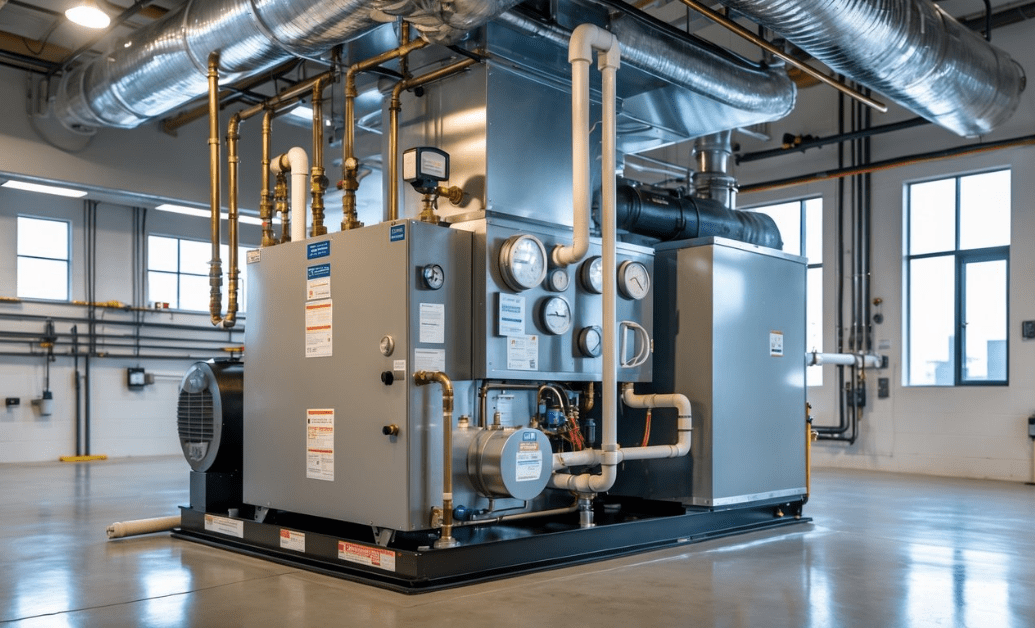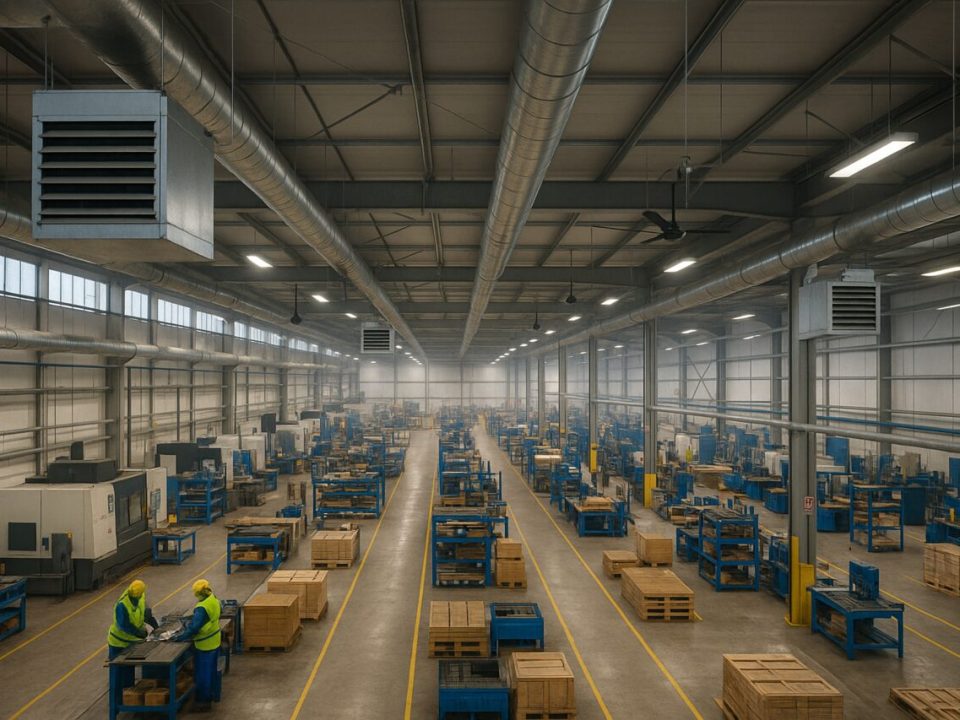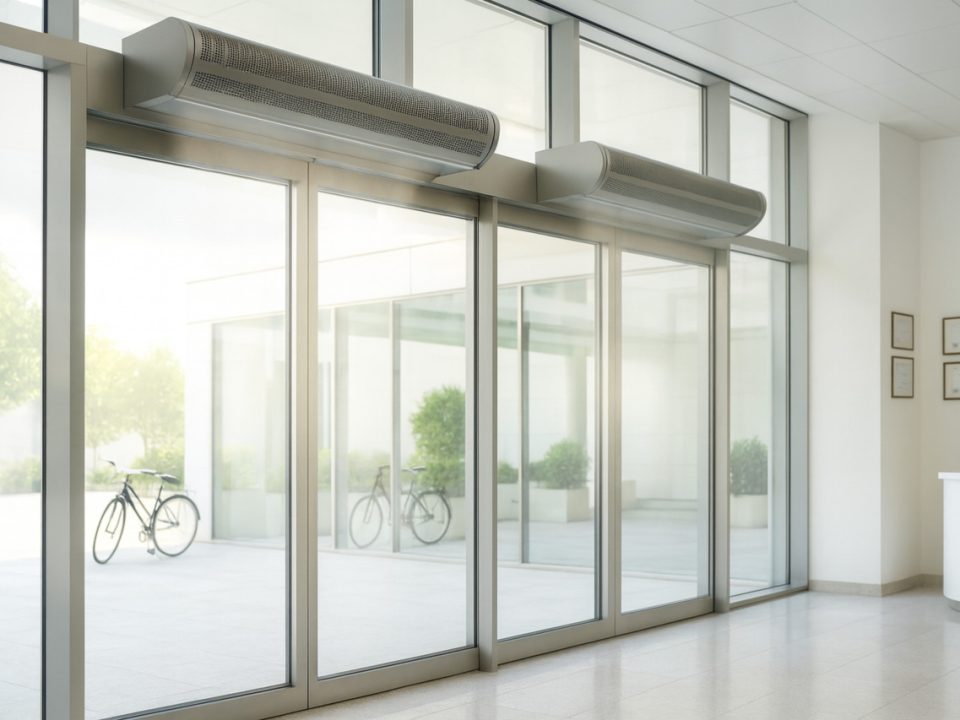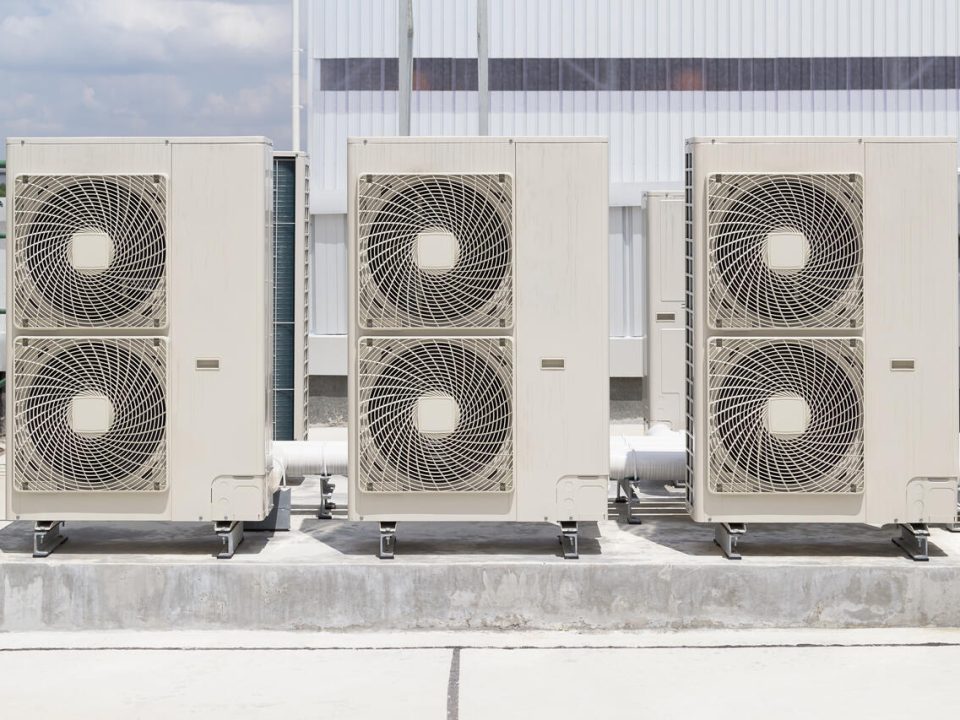
Why Factory Ventilation Matters: The Dangers of Silica Dust in Industrial Workspaces
July 22, 2025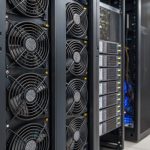
Data Centre Cooling Systems: Which One Is Right for You?
August 1, 2025Table of Contents
Commercial heating plays a crucial role in keeping buildings operational, comfortable, and compliant year-round. With energy prices rising and sustainability targets tightening, the right heating system can have a major impact on both operating costs and environmental performance.
This guide explores the most common types of commercial heating systems, their relative efficiencies, typical costs, and what to consider when choosing the best solution for your site.
Why Efficiency Matters in Commercial Heating
Heating can account for as much as 50% of a commercial building’s total energy use, making it one of the most significant contributors to operational costs and carbon emissions. In the UK, heating buildings contributes to approximately 18% of the country’s greenhouse gas emissions, with the commercial sector representing a substantial share of that figure.
Improving heating efficiency isn’t just about cutting energy bills. It also supports compliance with building regulations, helps meet sustainability targets, and can improve a company’s public image. High-efficiency systems reduce energy waste, lower maintenance requirements, and often qualify for government incentives or tax relief.
Choosing a system with a higher seasonal efficiency ratio or Coefficient of Performance (COP) can lead to long-term savings without compromising performance. When integrated into a well-maintained HVAC strategy, an efficient heating solution becomes an asset, not a liability.
Key Types of Commercial Heating Systems
There are several types of commercial heating systems available, each with distinct advantages depending on the building type, energy strategy, and budget. Below is an overview of the most commonly used systems.
1. Warm Air Heating Systems
Warm air heating systems use gas or oil to heat air, which is then distributed via ducts. They are ideal for large open spaces such as warehouses and factories, offering rapid heat-up times and efficient zone control. When properly maintained, modern units can reach seasonal efficiencies of over 90%.
Inergy offers tailored warm air heating solutions designed to meet the specific needs of industrial and commercial buildings.
2. Radiant Heating Systems
Radiant systems heat objects and people directly, rather than the air. This makes them particularly effective in areas with high ceilings or intermittent occupancy, such as logistics hubs or loading bays. They provide fast comfort levels with lower energy use, particularly in drafty environments.
To explore how this technology works in practice, see Inergy’s radiant heating services.
3. Condensing Boilers
Condensing boilers capture and reuse heat from exhaust gases, achieving efficiency levels of up to 98%. They are a common upgrade path for existing wet heating systems, offering a balance of efficiency, reliability, and relatively low installation costs.
4. Heat Pumps (Air, Ground, and Hybrid)
Heat pumps transfer heat from outside sources into the building. They offer impressive energy efficiency, with Coefficients of Performance (COPs) typically ranging between 3 and 5, meaning they can produce three to five units of heat for every unit of electricity consumed. Air source heat pumps are more common due to simpler installation, while ground source systems offer greater year-round stability and efficiency.
5. Heat Recovery Systems
Heat recovery ventilation (HRV) units can reclaim up to 95% of heat from exhaust air. When integrated with existing HVAC systems, they reduce the need for supplementary heating and contribute to improved indoor air quality.
6. District Heating and Communal Systems
Where available, heat networks allow buildings to connect to a shared energy source. This can reduce onsite equipment needs and enable participation in low-carbon schemes. These systems are gaining traction in urban developments and public sector projects.
System Comparison: Efficiency, Costs, Pros and Cons
Selecting a heating system involves balancing efficiency, installation cost, operating expenses, and suitability for your building. The table below offers a high-level comparison of the most common commercial heating systems.
| System Type | Efficiency (Typical) | Install Cost (Est.) | Lifespan (Years) | Key Benefits | Limitations |
|---|---|---|---|---|---|
| Warm Air Heating | 85–92% | £5,000–£15,000+ | 10–15 | Fast heat-up, ideal for large open spaces | Less suitable for multi-room heating |
| Radiant Heating | 90–95% | £4,000–£12,000+ | 15–20 | Efficient in high-ceiling areas | Minimal air circulation |
| Condensing Boilers | 90–98% | £3,000–£10,000+ | 10–15 | High efficiency, compact, upgrade-friendly | Dependent on fossil fuels |
| Air Source Heat Pumps | COP 3–4.5 | £10,000–£25,000+ | 15–20 | Low carbon, high efficiency | May require backup heating in extreme cold |
| Ground Source Heat Pumps | COP 4–5+ | £20,000–£50,000+ | 20+ | Stable year-round performance | High installation cost and space needed |
| Heat Recovery Systems | 60–95% heat recovery | £2,000–£8,000+ | 10–15 | Boosts efficiency of other systems | Best as part of a wider HVAC strategy |
Note: Costs are indicative and vary based on building size, existing infrastructure, and customisation needs.
Several studies have found that heat pumps can reduce heating bills by up to 30% compared to traditional gas systems, especially when combined with solar generation or smart controls. Radiant heating systems also offer significant savings in intermittently used spaces, reducing wasted energy from heating unused air volumes.
You can learn more about performance in different environments in Inergy’s post on choosing the right heating system for warehouses.
Choosing the Right System for Your Business
The best commercial heating system depends on your building’s layout, usage patterns, energy goals, and infrastructure. There’s no one-size-fits-all answer, but asking the right questions early on can help narrow the field.
Important Considerations
- Building Size and Layout: High-ceilinged buildings like warehouses often benefit from radiant or warm air heating. Office blocks with multiple zones may suit condensing boilers or heat pumps with zoning controls.
- Occupancy Patterns: Intermittent use calls for systems with fast response times, such as radiant heaters. Buildings with stable, round-the-clock usage may gain more from slow but steady systems like ground source heat pumps.
- Existing Infrastructure: Retrofitting a condensing boiler into an existing wet heating system is typically more cost-effective than installing an entirely new heat pump setup.
- Energy Source and Fuel Availability: Availability of gas, electricity, or renewables can steer the decision. Hybrid systems or low-carbon options may qualify for financial incentives or tax relief.
- Sustainability Goals: For buildings subject to environmental reporting or net-zero targets, high-efficiency heat pumps and HRV systems offer measurable emissions reductions.
Maintenance requirements should also influence your decision. A well-maintained system runs more efficiently, avoids costly downtime, and extends system lifespan. Inergy provides a full range of HVAC maintenance and service packages to help clients get the most from their investment.
Costs and ROI: What to Expect
Installing a new commercial heating system is a significant investment, but long-term savings and energy efficiency gains often outweigh the upfront costs. Understanding typical pricing and the potential return on investment helps build a stronger business case.
Installation Costs
Installation prices vary depending on system type, building size, complexity, and whether you’re retrofitting or starting from scratch. Here are some indicative cost ranges:
- Condensing boiler systems: £3,000 to £10,000+
- Warm air heating: £5,000 to £15,000+
- Radiant heating: £4,000 to £12,000+
- Air source heat pumps: £10,000 to £25,000+
- Ground source heat pumps: £20,000 to £50,000+
Systems that require ductwork, excavation, or significant electrical upgrades will naturally carry higher costs. However, these can often be offset by lower long-term energy bills.
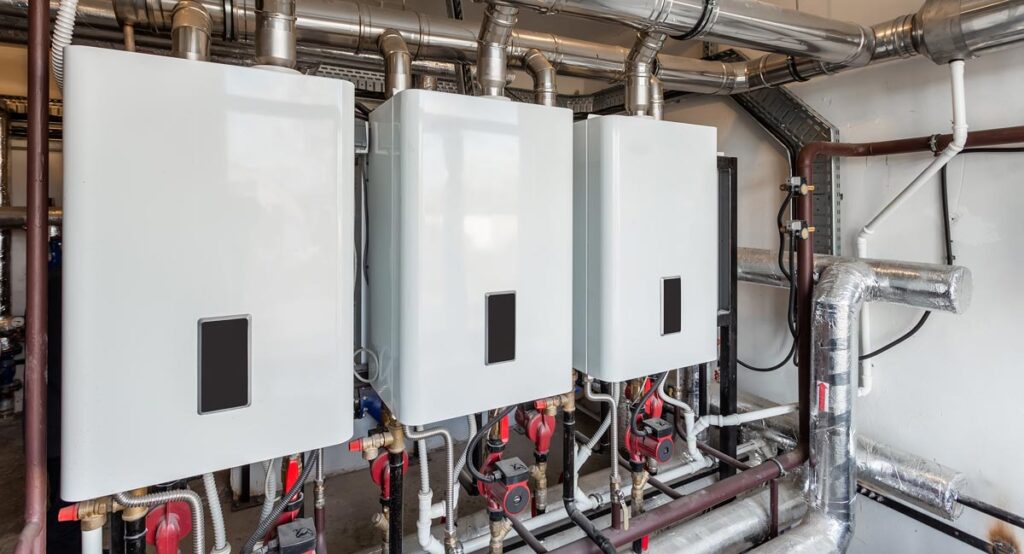
Operational Savings
According to industry reports, air source heat pumps can cut heating bills by up to 30% when replacing older gas or oil-based systems. Similarly, radiant heating systems can reduce energy use by targeting heat where it’s needed most, especially in large or partially occupied spaces.
Lifespan and Payback
Most high-efficiency heating systems last between 15 and 20 years, with some ground source installations operating for even longer. Payback periods typically range from 5 to 10 years, depending on usage levels and current energy prices.
Incentives and Support
Eligible installations may qualify for government support through schemes such as the Boiler Upgrade Scheme, which provides grants of up to £7,500 for air or ground source heat pumps. VAT relief is also available for energy-saving installations under certain conditions.
Choosing a partner with experience in optimising ROI can significantly improve outcomes. Inergy’s commercial heating services include detailed site assessments, helping clients balance performance, cost, and sustainability from day one.
Regulatory and Sustainability Drivers
Compliance with energy regulations and sustainability goals is no longer optional for many organisations. Heating systems are a central part of meeting both current legal requirements and future environmental commitments.
Regulatory Standards
Modern heating installations must meet standards under the UK’s Ecodesign and Energy Labelling directives, which set minimum seasonal efficiency thresholds. Equipment that falls short cannot legally be installed in new builds or during significant refurbishments.
In addition, all non-domestic buildings require a valid Energy Performance Certificate (EPC), with heating efficiency forming a major part of the calculation. Improving your heating system is one of the fastest ways to increase a building’s EPC rating.
Building control requirements and planning regulations may also mandate low-carbon technologies in new developments. Some local authorities follow the “Merton Rule,” which requires at least 10% of energy in new commercial builds to come from on-site renewables.
Net-Zero and ESG Commitments
Heating is a major contributor to a building’s carbon footprint. Switching to low-carbon systems like heat pumps or integrating heat recovery technologies supports net-zero targets and aligns with environmental, social, and governance (ESG) goals.
Customers and stakeholders increasingly expect sustainability to be built into operations. Upgrading to an energy-efficient heating system is a practical step toward demonstrating your environmental commitment and reducing long-term climate-related risks.
FAQs and Common Concerns
Do heat pumps work in cold weather?
Yes, modern air source heat pumps are designed to operate efficiently even in sub-zero temperatures. While efficiency may drop slightly during cold spells, most systems continue to perform reliably with appropriate sizing and insulation.
Which is cheaper in the long run: a boiler or a heat pump?
Although heat pumps typically have a higher installation cost, they can deliver lower energy bills over time due to higher efficiency. Over a 10–15-year period, total cost of ownership is often lower than for traditional gas boilers, particularly if paired with renewables.
Is radiant heating noisy?
No. Radiant heating systems are quiet because they do not rely on fans or ductwork. This makes them suitable for environments where noise reduction is important, such as workshops, assembly areas, or customer-facing spaces.
Can I retrofit an existing system or do I need a full replacement?
In many cases, systems like condensing boilers or warm air heaters can be retrofitted into existing infrastructure. Heat pumps may require more significant changes, especially in older buildings, but hybrid solutions and phased upgrades are often available.
What about space requirements?
Radiant heaters and wall-mounted units are typically compact and ideal for high-ceilinged buildings. Heat pumps may require external units and buffer tanks, but clever placement and modular system design can help minimise space constraints.
Is ongoing maintenance complicated or expensive?
Regular maintenance is essential for efficiency and safety, but it doesn’t need to be complex. Partnering with a specialist like Inergy helps ensure timely servicing and system optimisation. Explore our HVAC maintenance services for a breakdown of what’s involved.
Why Inergy?
At Inergy, we design, install, and maintain commercial heating systems that are built for performance, longevity, and sustainability. With decades of experience across sectors including manufacturing, logistics, retail, and education, we understand the pressures our clients face, from rising energy costs to regulatory compliance.
Our solutions are tailored to the unique needs of each building. Whether you’re looking to upgrade a gas-fired warm air heater, integrate a renewable heat pump system, or maximise comfort with radiant heating, we bring the technical expertise and on-site insight needed to get it right.
We provide full-service support from initial survey through to commissioning and aftercare. Our engineers operate nationwide, with established coverage in regions including Glasgow, London, and Cardiff. Every project is delivered with energy performance in mind, helping you cut waste, reduce bills, and future-proof your operations.
If you’re exploring heating upgrades as part of a wider energy strategy, take a look at our services for commercial and industrial heating systems or browse our insights on energy-efficient commercial heating.
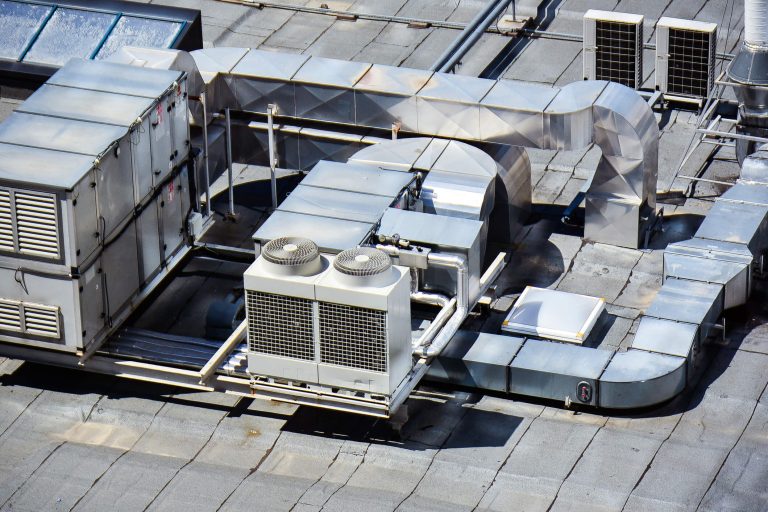
Commercial Heating: Time to Install or Upgrade?
Upgrading your commercial heating system is one of the most effective ways to reduce energy costs, improve building performance, and meet long-term sustainability goals. Whether you’re focused on lowering emissions, cutting bills, or modernising outdated infrastructure, the right system can deliver lasting impact.
If you’re ready to explore your options, we’re here to help. From design and specification through to installation and maintenance, we provide end-to-end support to make your transition smooth, efficient, and future-ready.
Get in touch to arrange a site survey or speak to one of our commercial heating specialists. You can also explore our blog for guidance on heating system choices for warehouses or tips on preparing your HVAC for winter.

